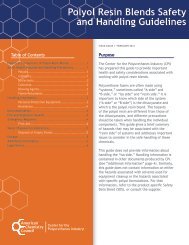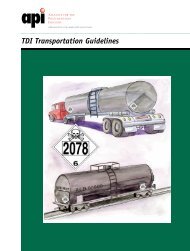MDI Transportation Guidelines - Polyurethanes - American ...
MDI Transportation Guidelines - Polyurethanes - American ...
MDI Transportation Guidelines - Polyurethanes - American ...
Create successful ePaper yourself
Turn your PDF publications into a flip-book with our unique Google optimized e-Paper software.
<strong>MDI</strong> transportation<br />
g u i d e l i n e s<br />
Chapter 11: Unloading Operations for Tank Trucks and Rail Tank Cars<br />
11.1 Criteria for Discharge Facilities<br />
The operation of discharging <strong>MDI</strong> from any bulk container may present risk of certain physical and health<br />
hazards. Consequently, it is important that discharge facilities be correctly designed and constructed, and<br />
properly used and maintained.<br />
11.2 Design, Location and Checks<br />
Discharging facilities should be designed and located for the handling requirements associated with <strong>MDI</strong>.<br />
A preventive maintenance program covering all equipment should be developed to ensure proper operation<br />
(See Appendix 3).<br />
11.3 Criteria for Discharge<br />
Off-loading hoses and vapor return hoses should be 2-inch diameter, color-coded red, and stamped “For<br />
Diisocyanate Use Only.” Materials of construction should be suitable for diisocyanates. The hoses should be<br />
clean, dry and capped when not in use. Pressure testing is recommended prior to their first use and at least<br />
quarterly thereafter. Two-inch diameter hoses are the recommended industry standard for unloading <strong>MDI</strong> and<br />
for vapor exchange.<br />
11.4 Operating Procedures<br />
Written operating procedures should be prepared covering all aspects of the discharge of <strong>MDI</strong>. In the case of<br />
tank truck unloading, the division of responsibilities between the driver and receiver should be clearly<br />
defined. See Appendix 2 for specific recommendations on the division of responsibilities between the tank<br />
truck driver and the receiver. See Appendix 3 for specific recommendations for unloading from a rail tank car.<br />
Reference 49 CFR § 177.834 for attendance requirements for tank truck unloading and 49 CFR § 174.67 for<br />
rail car unloading.<br />
11.5 Protective Equipment for Operators<br />
All necessary personal protective equipment should be available for discharging operations (See Chapter 6<br />
for further details). Persons must be trained in the correct use of this equipment. Whenever the driver of a<br />
tank truck leaves his vehicle, he should take with him the appropriate personal protective equipment to be<br />
sure of its availability in the event of an emergency.<br />
11.6 Inspection of the Bulk Reception Facilities<br />
The customer is generally responsible for controlling the conditions of receipt. Customers should work with<br />
their suppliers to ensure that good safety standards have been developed for handling and storage. See<br />
Appendix 4 for a checklist of general industry recommendations that provides companies with guidelines for<br />
ensuring the safe handling and storage of <strong>MDI</strong>.<br />
Copyright 2001, <strong>American</strong> Plastics Council<br />
29

















